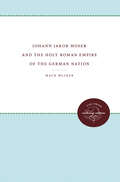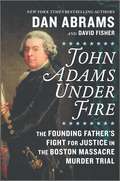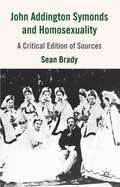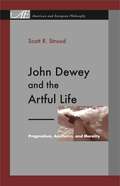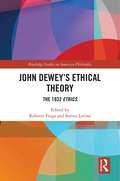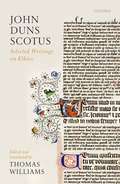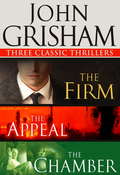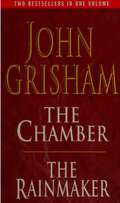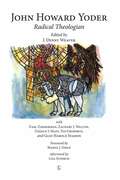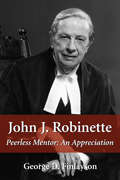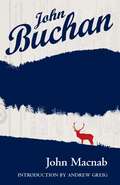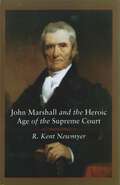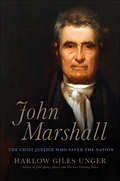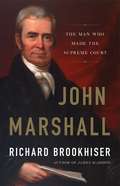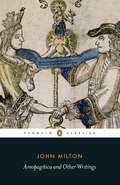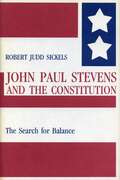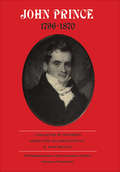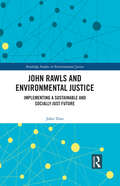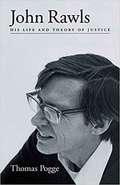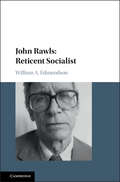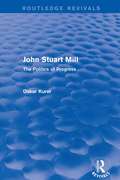- Table View
- List View
Johann Jakob Moser and the Holy Roman Empire of the German Nation
by Mack WalkerAs the most learned and eminent public lawyer in Germany, a busy administrator, and a prolific writer, Moser (1701-85) lived and breathed the political order. His correspondence, memoranda, and manuscript autobiography reflect the intricate day-to-day operations of the empire, and his fascinating life is a microcosm of the life and style of the empire itself. The biography provided a comprehensive picture of the empire between the Thirty Years War and the revolutionary era.Originally published 1981.A UNC Press Enduring Edition -- UNC Press Enduring Editions use the latest in digital technology to make available again books from our distinguished backlist that were previously out of print. These editions are published unaltered from the original, and are presented in affordable paperback formats, bringing readers both historical and cultural value.
John Adams Under Fire: The Founding Father's Fight for Justice in the Boston Massacre Murder Trial
by David Fisher Dan AbramsThe New York Times bestselling author of Lincoln’s Last Trial and host of LivePD Dan Abrams and David Fisher tell the story of a trial that would change history. <P><P>History remembers John Adams as a Founding Father and our country’s second president. But in the tense years before the American Revolution, he was still just a lawyer, fighting for justice in one of the most explosive murder trials of the era.On the night of March 5, 1770, shots were fired by British soldiers on the streets of Boston, killing five civilians. <P><P>The Boston Massacre has often been called the first shots of the American Revolution. As John Adams would later remember, “On that night the formation of American independence was born.” Yet when the British soldiers faced trial, the young lawyer Adams was determined that they receive a fair one. He volunteered to represent them, keeping the peace in a powder keg of a colony, and in the process created some of the foundations of what would become United States law. <P><P>In this book, New York Times bestselling authors Dan Abrams and David Fisher draw on the trial transcript, using Adams’s own words to transport readers to colonial Boston, a city roiling with rebellion, where British military forces and American colonists lived side by side, waiting for the spark that would start a war. <P><P><b>A New York Times Bestseller</b>
John Addington Symonds (1840–1893) and Homosexuality
by Sean BradyIn John Addington Symonds (1840 1893) and Homosexuality: A Critical Edition of Sources, Sean Brady brings together for the first time the correspondence between John Addington Symonds and Havelock Ellis on the project of Sexual Inversion. Ellis'Sexual Inversion became eventually his totemic Studies in the Psychology of Sex. But in many respects, the project Sexual Inversion was Symonds' brainchild. Ellis and Symonds never actually met, so the correspondence represents their completecommunication on the subject. Many of the letters in this critical source edition are published here for the first time, and the correspondence in its entirely has never been published together. This critical source edition also publishes Symonds' original privately printed essays, 'A Problem in Greek Ethics', and 'A Problem in Modern Ethics'. Sean Brady's critical introduction provides a new and interdisciplinary analysis of the significance of these texts, the correspondence, and of Symonds' place in the history of ideas and of gender and sexuality. This volume is an indispensable reference for a wide range of scholars working across multidisciplinary fields of inquiry that focus on British and continental histories of medicine and sexuality, gender history and studies of nineteenth-century culture, and introduces the new reader to Symonds' life and ideas on homosexuality. "
John Dewey and the Artful Life: Pragmatism, Aesthetics, and Morality (American and European Philosophy #7)
by Scott R. StroudAesthetic experience has had a long and contentious history in the Western intellectual tradition. Following Kant and Hegel, a human’s interaction with nature or art frequently has been conceptualized as separate from issues of practical activity or moral value. This book examines how art can be seen as a way of moral cultivation. Scott Stroud uses the thought of the American pragmatist John Dewey to argue that art and the aesthetic have a close connection to morality. Dewey gives us a way to reconceptualize our ideas of ends, means, and experience so as to locate the moral value of aesthetic experience in the experience of absorption itself, as well as in the experience of reflective attention evoked by an art object.
John Dewey’s Ethical Theory: The 1932 Ethics (Routledge Studies in American Philosophy)
by Roberto FregaThis book provides a wide-ranging, systematic, and comprehensive approach to the moral philosophy of John Dewey, one of the most important philosophers of the 20th century. It does so by focusing on his greatest achievement in this field: the Ethics he jointly published with James Hayden Tufts in 1908 and then republished in a heavily revised version in 1932. The essays in this volume are divided into two distinct parts. The first features essays that provide a running commentary on the chapters of the 1932 Ethics written by Dewey. Each chapter is introduced, situated within a historical perspective, and then its main achievements are highlighted and discussed. The second part of the book interprets the Ethics and demonstrates its contemporary relevance and vitality. The essays in this part situate the Ethics in the broader interpretive frameworks of Dewey’s philosophy, American pragmatism, and 20th-century moral theory at large. Taken together, these essays show that, far from being a mere survey of moral theories, the 1932 Ethics presents the theoretical highpoint in Dewey’s thinking about moral philosophy. This book features contributions by some of the most influential Dewey scholars from North America and Europe. It will be of keen interest to scholars and students of American pragmatism, ethics and moral philosophy, and the history of 20th-century philosophy.
John Duns Scotus: Selected Writings On Ethics
by Thomas WilliamsThomas Williams presents the most extensive collection of John Duns Scotus's work on ethics and moral psychology available in English. John Duns Scotus: Selected Writings on Ethics includes extended discussions-and as far as possible, complete questions-on divine and human freedom, the moral attributes of God, the relationship between will and intellect, moral and intellectual virtue, practical reasoning, charity, the metaphysics of goodness and rightness, the various acts, affections, and passions of the will, justice, the natural law, sin, marriage and divorce, the justification for private property, and lying and perjury.
John Grisham (3-Book Bundle): The Firm, The Appeal, The Chamber
by John GrishamThe #1 New York Times bestselling master of legal suspense, John Grisham has electrified readers with his white-knuckle narratives for more than two decades. Assembled here in a convenient eBook bundle are three of his classic thrillers: The Firm, the runaway hit that ignited his writing career, The Appeal, and The Chamber. Read back-to-back or enjoyed separately, these edge-of-your-seat novels show why John Grisham is--beyond a reasonable doubt--one of the most beloved authors of all time. THE FIRM When Mitch McDeere signed on with Bendini, Lambert & Locke of Memphis, he thought that he and his beautiful wife, Abby, were on their way. The firm leased him a BMW, paid off his school loans, arranged a mortgage, and hired the McDeeres a decorator. Mitch should have remembered what his brother Ray--doing fifteen years in a Tennessee jail--already knew: You never get nothing for nothing. Now the FBI has the lowdown on Mitch's firm and needs his help. Mitch is caught between a rock and a hard place, with no choice--if he wants to live. THE APPEAL In a crowded courtroom in Mississippi, a jury returns a shocking verdict against a chemical company accused of dumping toxic waste into a small town's water supply, causing the worst "cancer cluster" in history. The company appeals to the Mississippi Supreme Court, whose nine justices will one day either approve the verdict--or reverse it. The chemical company is owned by a Wall Street predator named Carl Trudeau, and Mr. Trudeau is convinced the Court is not friendly enough to his interests. With judicial elections looming, he decides to try to purchase himself a seat on the Court. The cost is a few million dollars, a drop in the bucket for a billionaire like Mr. Trudeau. Through an intricate web of conspiracy and deceit, his political operatives recruit a young, unsuspecting candidate. They finance him, manipulate him, market him, and mold him into a potential Supreme Court justice. Their Supreme Court justice. THE CHAMBER In Chicago's top law firm, a young lawyer stands on the brink of a brilliant career. Now twenty-six-year-old Adam Hall is risking it all for a death-row killer and an impossible case: Sam Cayhall is a former Klansman and unrepentant racist facing the death penalty for a fatal bombing in 1967. Cayhall has run out of chances--except for one: a determined lawyer who just happens to be his grandson. While the executioners prepare the gas chamber, while the protesters gather, and while the TV cameras wait, Adam has only days, hours, minutes to save his client. For between the two men is a chasm of shame, family lies, and secrets--including the one secret that could save Sam Cayhall's life . . . or cost Adam his.
John Grisham Omnibus: The Chamber And The Rainmaker
by John GrishamFrom the world’s number one bestselling author; two more electrifying legal thrillers in one bumper volume. THE CHAMBER: Adam Hill is a rookie lawyer at a top Chicago firm. The world is at his feet. So why does he volunteer to represent a KKK terrorist under threat of execution? And why is the defendant happy to put his life in a novice's hands? The answer lies twenty years in the past, but there are darker, more shocking secrets to be uncovered... THE RAINMAKER: Rudy Baylor is a rookie lawyer about to take on a career-defining case, fighting for justice for a young man whose death could easily have been prevented. This case has the power to change everything for Rudy - eliminate his debts and save his legal practice. But he has never argued a case in court before. And he is up against the most expensive lawyers that money can buy. Can Rudy win against the odds? Or will the truth be buried forever?
John Grisham Omnibus: The Client, The Street Lawyer
by John GrishamTHE CLIENT: The Law, the Mob, a murder - and the mind of an eleven-year old child... An eleven-year-old has discovered a secret that not even an adult should know. A US State Senator is dead, and Mark Sway is the only one who knows where the body is hidden. The FBI want him to tell them where it is at whatever cost to Mark and his family. The killer wants him silenced forever. Only one lawyer can save him from these twin threats. Together with Mark she must take on the might of the State and the wiles of a cold-blooded killer. THE STREET LAWYER: Michael was in a hurry. He was scrambling up the ladder at Drake + Sweeney, a giant Washington law firm. The money was good and getting better and a partnership was three years away. He was a rising star, with no time to waste, no time to stop, no time to toss a few coins into the cups of panhandlers, no time for a conscience. But a violent encounter with a homeless man stopped him cold. Michael survived, his assailant did not. Who was this homeless man? Michael did some digging and found a dirty secret and the secret involved Drake + Sweeney. Soon Michael was in the street, a thief, on the run from the very dreams he once valued above everything else…
John Grisham Omnibus: The Partner and The Runaway Jury
by John GrishamTHE PARTNER: They kidnapped him in a small town in Brazil. He had changed his name and his appearance, but they were sure they had their man. Four years before, he had been called Patrick S. Lanigan. He had died in a car crash in February 1992. He had been a partner at an up and coming law firm, had a pretty wife, a new daughter, and a bright future. Six weeks after his death, $90 million had disappeared from the law firm. It was then that his partners knew he was still alive, and the long pursuit began... THE RUNAWAY JURY: In Biloxi, Mississippi, a landmark trial with hundreds of millions of dollars at stake begins routinely, then swerves mysteriously off course. The jury is behaving strangely, and one juror is convinced he’s being watched. Then a tip from an anonymous young woman suggests she is able to predict the jurors’ odd behaviour. Is the jury somehow being manipulated, or even controlled? If so by whom? And more importantly, why?
John Grisham Omnibus: The Pelican Brief And A Time To Kill
by John GrishamTwo electrifying legal thrillers in one bumper volume from the author of The Firm. The Pelican Brief: Two Supreme Court Judges are dead. Their murders are connected only in one mind, and in one legal brief, conceived by that mind. Law student Darby Shaw thinks she has found the obscure link between the two murders and in a meticulous but wildly speculative brief she names the suspect. Realizing her life is threatened she goes underground until journalist Gray Grantham discovers new evidence, which leads him to believe that Darby has stumbled upon the biggest cover-up since Watergate. Their only aim is to stay alive to expose the real truth behind The Pelican Brief. A Time to Kill: When a black man guns down the two whites who raped his ten-year-old daughter, the people of Clanton, Mississippi see their town fill with an angry mob. The young defence lawyer Jake Brigance may be risking more than his career when he takes the case.
John Grisham Omnibus: The Summons and The King Of Torts
by John GrishamTHE SUMMONS: Ray Atlee is a professor of law at the university of Virginia who is forty-three and newly single. He has a father, a very sick old man who lives alone in the ancestral home in Clanton, Mississippi; a beloved and powerful official who has towered over local law and politics for many years and is now a recluse. With the end in sight, Judge Atlee issues a summons to Ray to return home to Clanton, to discuss the details of his estate. Ray reluctantly heads south. But the meeting does not take place. The Judge dies too soon, and in doing so leaves behind a shocking secret known only to Ray. And perhaps someone else. THE KING OF TORTS: The Office of the Public Defender is not known as a training ground for bright young litigators. Clay Carter has been there too long, and, like most of his colleagues, dreams of a better job in a real firm. When he reluctantly takes the case of a young man charged with a random street killing, he assumes it is just another of the many senseless murders that hit Washington D.C. every week. As he digs into the background of his client, Clay stumbles upon a conspiracy too horrible to believe. He suddenly finds himself in the middle of a complex case against one of the largest pharmaceutical companies in the world, looking at the kind of enormous settlement that would totally change his life—that would make him, almost overnight, the legal profession’s newest king of torts.
John Howard Yoder: Radical Theologian
by J Denny Weaver'John Howard Yoder: Radical Theologian' shows that for John Howard Yoder both theology (in particular Christology) and ethics are expressions of the meaning of the narrative of Jesus. All such statements are relative to a particular context, so thattheology and ethics are subject to reaching back to the narrative in order to restate the meaning in new and ever-changing contexts. This methodology is visible in Yoder's 'Preface to Theology', which has been little used in most treatments of Yoder's thought. Yoder has been characterised as standing on Nicene orthodoxy, criticised for rejecting Nicene orthodoxy, called heterodox, and designated a postmodern thinker to be interpreted in terms of other such thinkers. None of these characterisations adequately locates the basis of his methodology in the narrative of Jesus. Thus 'John Howard Yoder: Radical Theologian' aims to go beyond or to supersede existing treatments with its demonstration that Yoder is a radical theologian in the historical meaning of radical - that is, as one who returns to the root - but also relates his theology to the personal accusations that clouded his later years. For Christian faith, this root is Christ. Parts II and III of the book explore the sources of Yoder's approach, and its application in several contemporary contexts.
John J. Robinette: An Appreciation
by George D. FinlaysonJohn J. Robinette, Canada’s greatest trial lawyer, was admired and respected by the bench and his fellow lawyers alike. A quiet, unassuming man outside the courtroom, he was a consummate performer when appearing before a judge and jury. Robinette became a household name as the defender of Evelyn Dick, who was charged with killing her husband and infant son in Hamilton in 1946, and of Steven Suchan, a member of the infamous Boyd Gang. He was Canada’s pre-eminent lawyer from the 1930s to the 1980s, showing unparalleled versatility and virtuosity whether acting as counsel in criminal, civil, or constitutional cases, at both the trial and appeal levels. This is the story of a great man, of the maturing of the legal profession in Canada, and of Canada in the twentieth century.
John Macnab
by John Buchan Andrew GreigIn 1925, John Buchan published his second most famous novel, "John MacNab"; three high-flying men -- a barrister, a cabinet minister and a banker -- are suffering from boredom. They concoct a plan to cure it. They inform three Scottish estates that they will poach from each two stags and a salmon in a given time. They sign collectively as 'John McNab' and await the responses. This novel is a light interlude within the "Leithen Stories" series - an evocative look at the hunting, shooting and fishing lifestyle in Highland Scotland.
John Marshall and the Heroic Age of the Supreme Court (Southern Biography Series)
by R. Kent NewmyerJohn Marshall (1755--1835) was arguably the most important judicial figure in American history. As the fourth chief justice of the United States Supreme Court, serving from 1801 to1835, he helped move the Court from the fringes of power to the epicenter of constitutional government. His great opinions in cases like Marbury v. Madison and McCulloch v. Maryland are still part of the working discourse of constitutional law in America. Drawing on a new and definitive edition of Marshall's papers, R. Kent Newmyer combines engaging narrative with new historiographical insights in a fresh interpretation of John Marshall's life in the law. More than the summation of Marshall's legal and institutional accomplishments, Newmyer's impressive study captures the nuanced texture of the justice's reasoning, the complexity of his mature jurisprudence, and the affinities and tensions between his system of law and the transformative age in which he lived. It substantiates Oliver Wendell Holmes Jr.'s view of Marshall as the most representative figure in American law.
John Marshall: The Chief Justice Who Saved the Nation
by Harlow Giles UngerA soul-stirring biography of John Marshall, the young republic's great chief justice, who led the Supreme Court to power and brought law and order to the nation
John Marshall: The Man Who Made the Supreme Court
by Richard BrookhiserThe life of John Marshall, Founding Father and America's premier chief justice In 1801, a genial and brilliant Revolutionary War veteran and politician became the fourth chief justice of the United States. He would hold the post for 34 years (still a record), expounding the Constitution he loved. Before he joined the Supreme Court, it was the weakling of the federal government, lacking in dignity and clout. After he died, it could never be ignored again. Through three decades of dramatic cases involving businessmen, scoundrels, Native Americans, and slaves, Marshall defended the federal government against unruly states, established the Supreme Court's right to rebuke Congress or the president, and unleashed the power of American commerce. For better and for worse, he made the Supreme Court a pillar of American life. In John Marshall, award-winning biographer Richard Brookhiser vividly chronicles America's greatest judge and the world he made.
John Milton: Areopagitica and Other Writings
by John Milton William PooleJohn Milton was celebrated and denounced in his own time both as a poet and as a polemicist. Today he is remembered first and foremost for his poetry, but his great epic Paradise Lost was published very late in his life, in 1667, and in his own time most readers more readily recognized Milton as a writer of prose. This superbly annotated new book is an authoritative edition of Milton’s major prose works, including Of Education, The Tenure of Kings and Magistrates, and the Divorce tracts, as well as the famous 1644 polemical tract opposing licensing and censorship, Areopagitica. For more than sixty-five years, Penguin has been the leading publisher of classic literature in the English-speaking world. With more than 1,500 titles, Penguin Classics represents a global bookshelf of the best works throughout history and across genres and disciplines. Readers trust the series to provide authoritative texts enhanced by introductions and notes by distinguished scholars and contemporary authors, as well as up-to-date translations by award-winning translators.
John Paul Stevens and the Constitution: The Search for Balance
by Robert SickelsA good pragmatist's constitutional theory is inseparable from the legal disputes out of which it arises. John Paul Stevens's theory, that of deciding individual cases well instead of applying constitutional principles in the abstract to cases by category, thus lends itself to being studied in its natural, factual habitat—in his own words, case by case. That's what this book does. In Chapter 1 Sickels distills Stevens's thoughts about law and appellate judging from his early writings and his opinions on the federal appeals court and, from 1975 to the present, on the U.S. Supreme Court. Stevens shows a concern for facts and consequences, for balancing, for deference to other decision makers unless they have been careless, for avoidance of undue complexity in judge-made law, and for drawing the line between clarity and oversimplification in legal rules. The next three chapters describe the application of Stevens's pragmatism to areas of constitutional law to which the Court and he especially have devoted most attention in recent years: First Amendment guarantees of freedom of expression and religion, the procedural guarantees (broadly, due process) of the Bill of Rights and the Fourteenth Amendment, and the equal protection of the laws. In each area, Stevens's special contributions are described. The concluding chapter places Stevens's judging in the contexts of the ongoing debate about the legitimacy of balancing, the ways of other moderates on the Court, and the voting records of the other members of the Court as a whole.Unique to this work is a meaningful introduction to the term moderate when applied to a Supreme Court justice, a definition based on careful analysis of the interplay of general rules and specific, case-by-case context. As such it is the very essence of Stevens's own way of judging and thus enables analysis of the work of a pragmatist on his own terms rather than through the distortions of a conflicting theory of law. John Paul Stevens is recognized as a jurist of unusual ability and one adheres to no ideological camp. While it is one thing to know he is neither rigid liberal nor a conservative, this book goes beyond the "neither nor" to accomplish the more difficult goal of defining what he is.This study is intended for scholars and students of the Supreme Court, the Constitution, the courts, and the American political process. Lawyers working before the Supreme Court, informed generalists, and courtwatchers generally, whether liberal, conservative, or neutral, will find much of interest here.
John Prince 1796-1870: A Collection of Documents
by R. Alan DouglasJohn Prince was a lawyer, farmer, military officer, politician, judge, and entrepreneur. Born at Hereford, England, in 1796, he emigrated to Upper Canada in 1833 because he was ashamed of his ne'er-do-well father. His interest in farming took him to Sandwich where he became involved in the many careers open to him. An unhappy and volatile man, he was constantly at odds with himself, his family, and his associates. As colonel of the Third Essex Regiment, he was sometimes unpredictable in his actions and on one occasion, during the Upper Canada Rebellion, unjustifiably violent – ordering the summary execution of five prisoners after the Battle of Windsor. As a politician, despite his haughty and melancholic nature and his erratic individualism, he held the loyalty of his constituents, representing Essex in the House of Assembly from 1836 to 1854 and the Western Districts in the Legislative Council from 1856 to 1860. In 1860, after a lifetime spent in politics, farming, railroading and mining speculations, and canal schemes, he obtained a long-sought judgeship in the new District of Algoma. Leaving his wife and children behind, he went off to his 'New Siberia,' where he continued his restless struggle to escape 'the importunities of mankind,' and where his long, tragic life ended in 1870. Entries from Prince's diary, excerpts from newspaper accounts, and letters give a vivid picture of the politics and life of his time. In his Introduction, R. Alan Douglas emphasizes the contribution made by the discovery of the diary to our perception of the people, places, and events of mid-nineteenth century North America. (Ontario Series of the Champlain Society, 11)
John Rawls and Environmental Justice: Implementing a Sustainable and Socially Just Future (Routledge Studies in Environmental Justice)
by John TönsUsing the principles of John Rawls’ theory of justice, this book offers an alternative political vision, one which describes a mode of governance that will enable communities to implement a sustainable and socially just future. Rawls described a theory of justice that not only describes the sort of society in which anyone would like to live but that any society can create a society based on just institutions. While philosophers have demonstrated that Rawls’s theory can provide a framework for the discussion of questions of environmental justice, the problem for many philosophical theories is that discussions of sustainable development open the need to address questions of ecological interdependence, historical inequality in past resource use and the recognition that we cannot afford to ignore the limitations of growth. These ideas do not fit in comfortably in standard discourse about theories of justice. In contrast, this book frames the discussion of global justice in terms of environmental sustainability. The author argues that these ideas can be used to develop a coherent political theory that reconciles cosmopolitan arguments and the non-cosmopolitan or nationalist arguments concerning social and environmental justice. This book will be of great interest to students and scholars of environmental philosophy and ethics, moral and political philosophy, global studies and sustainable development.
John Rawls: His Life And Theory Of Justice
by Thomas Pogge Michelle KoschJohn Rawls was one of the most important political philosophers of our time, and promises to be an enduring figure over the coming decades. His Theory of Justice (1971) has had a profound impact across philosophy, politics, law, and economics. Nonetheless Rawlsian theory is not easy to understand, particularly for beginners, and his writing can be dense and forbidding. Thomas Pogge's short introduction (originally published in German) gives a thorough and concise presentation of the main outlines of Rawls's theory, introduces biographical information when necessary, and draws links between the Rawlsian enterprise and other important positions in moral and political philosophy.
John Rawls: Ideal Theory And Practical Demands
by William A. EdmundsonThis book is the first detailed reconstruction of the late work of John Rawls, who was perhaps the most influential philosopher of the twentieth century. Rawls's 1971 treatise, A Theory of Justice, stimulated an outpouring of commentary on 'justice-as-fairness,' his conception of justice for an ideal, self-contained, modern political society. Most of that commentary took Rawls to be defending welfare-state capitalism as found in Western Europe and the United States. Far less attention has been given to Rawls's 2001 book, Justice as Fairness: A Restatement. In the Restatement, Rawls not only substantially reformulates the 'original position' argument for the two principles of justice-as-fairness but also repudiates capitalist regimes as possible embodiments. Edmundson further develops Rawls's non-ideal theory, which guides us when we find ourselves in a society that falls well short of justice.
John Stuart Mill (Routledge Revivals): The Politics of Progress
by Oskar KurerFirst published in 1991, this book attempts to deal with Mill’s thought as a coherent system and tie some elements of his thoughts together. It seeks to show that he developed a set of ethical principles to underlie government intervention and provide a theory as to how it should intervene — which he then applied to practical politics. The first chapters deal with Mill’s doctrine of improvement and what impact the improvement of man has on the social organisation of society. The third chapter deals with Mill’s theory of economic development. The second part of the book deals with policy issues such as the question of the optimal constitution and Mill’s policy proposals for England.
